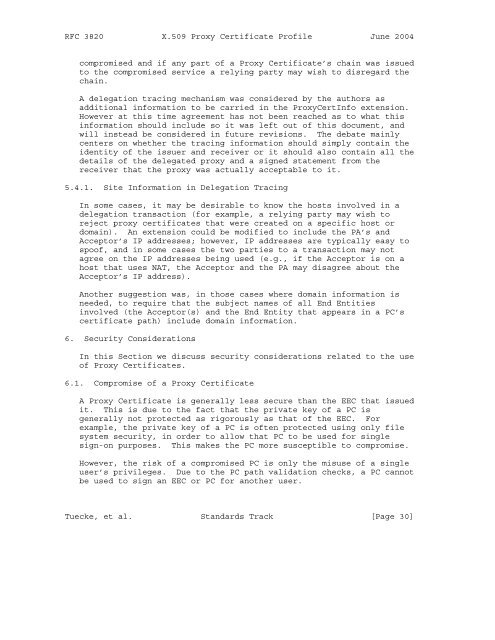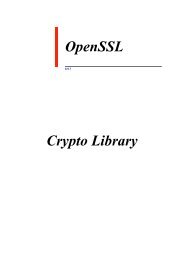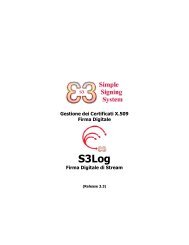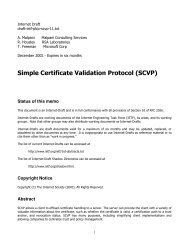Internet X.509 Public Key Infrastructure (PKI) Proxy ... - Clizio.com
Internet X.509 Public Key Infrastructure (PKI) Proxy ... - Clizio.com
Internet X.509 Public Key Infrastructure (PKI) Proxy ... - Clizio.com
You also want an ePaper? Increase the reach of your titles
YUMPU automatically turns print PDFs into web optimized ePapers that Google loves.
RFC 3820 <strong>X.509</strong> <strong>Proxy</strong> Certificate Profile June 2004<strong>com</strong>promised and if any part of a <strong>Proxy</strong> Certificate’s chain was issuedto the <strong>com</strong>promised service a relying party may wish to disregard thechain.A delegation tracing mechanism was considered by the authors asadditional information to be carried in the <strong>Proxy</strong>CertInfo extension.However at this time agreement has not been reached as to what thisinformation should include so it was left out of this document, andwill instead be considered in future revisions. The debate mainlycenters on whether the tracing information should simply contain theidentity of the issuer and receiver or it should also contain all thedetails of the delegated proxy and a signed statement from thereceiver that the proxy was actually acceptable to it.5.4.1. Site Information in Delegation TracingIn some cases, it may be desirable to know the hosts involved in adelegation transaction (for example, a relying party may wish toreject proxy certificates that were created on a specific host ordomain). An extension could be modified to include the PA’s andAcceptor’s IP addresses; however, IP addresses are typically easy tospoof, and in some cases the two parties to a transaction may notagree on the IP addresses being used (e.g., if the Acceptor is on ahost that uses NAT, the Acceptor and the PA may disagree about theAcceptor’s IP address).Another suggestion was, in those cases where domain information isneeded, to require that the subject names of all End Entitiesinvolved (the Acceptor(s) and the End Entity that appears in a PC’scertificate path) include domain information.6. Security ConsiderationsIn this Section we discuss security considerations related to the useof <strong>Proxy</strong> Certificates.6.1. Compromise of a <strong>Proxy</strong> CertificateA <strong>Proxy</strong> Certificate is generally less secure than the EEC that issuedit. This is due to the fact that the private key of a PC isgenerally not protected as rigorously as that of the EEC. Forexample, the private key of a PC is often protected using only filesystem security, in order to allow that PC to be used for singlesign-on purposes. This makes the PC more susceptible to <strong>com</strong>promise.However, the risk of a <strong>com</strong>promised PC is only the misuse of a singleuser’s privileges. Due to the PC path validation checks, a PC cannotbe used to sign an EEC or PC for another user.Tuecke, et al. Standards Track [Page 30]









